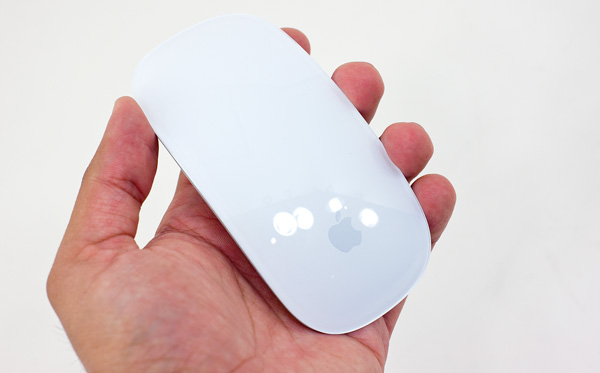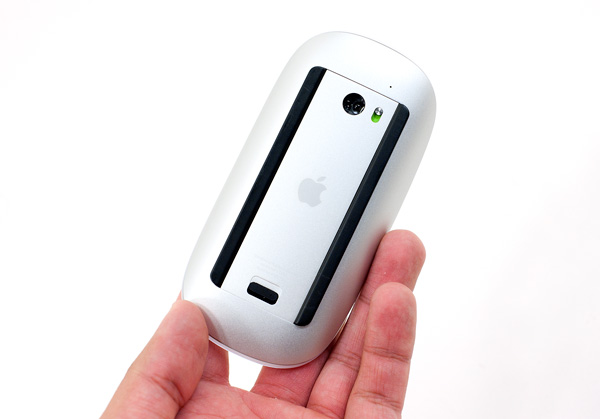Apple Mac Pro (Mid 2010) Review
by Anand Lal Shimpi on October 6, 2010 9:26 PM ESTInput Devices
The Mac Pro ships with two input devices by default: the Apple USB keyboard with numeric keypad, and the Magic Mouse.
The keyboard I'm a huge fan of. If you're ok with the relatively condensed design, it's great to type on. The angle feels just right, there's good feedback from the keys and even the key travel seems just right. The biggest issue is that it isn't an ergonomic design in the style of the Microsoft Natural keyboards.
You get a row of helpful function keys along the top and two USB ports integrated into the keyboard itself. The ports are only good for delivering 100mA of power so you'll have to look elsewhere to charge your iPhone/iPod.
I've used the keyboard before, it's actually what I do most of my writing on. I'd say there's still tons of room for improvement in the comfort department so I'd like to see Apple go back to the drawing board with its now 3-year old design. The mouse however, I'd never had any real experience with.
The Mighty Mouse was Apple's first attempt at a two-button mouse with a modern Mac. By using a touch sensor in the mouse itself you could push on the right side of the mouse to simulate a right click. A nifty way of adding a right mouse button without actually capitulating to the demands of the radical two buttoners.
The successor to the Mighty Mouse is named the Magic Mouse. Stylistically the Magic Mouse is probably the best looking mouse I've ever used. It looks great on a desk. Even the on/off switch underneath is well designed. It also takes touch to the next level. Instead of using a touch sensor to simply determine left from right clicks, you can now gesture on the surface of the mouse.
The supported gestures include scrolling (both horizontally and vertically) and two finger swipe to flip through photos or web pages.
The scrolling gestures are nice. I found myself getting excited whenever I’d have a window open that I needed to scroll in. It’s just so much more effortless than using a scrollwheel, even the newer low-friction wheels. But at the end of the day I just couldn't get over the ergonomics of the mouse. Matthew Witheiler, the first AnandTech Senior GPU Editor, swears by his but I couldn't get used to it. The Magic Mouse is extremely low profile and doesn't really contour to my hand at all. I suppose it's ok for occasional mousing but I simply point too often.
The Magic Mouse also lacks the smooth tracking feel that most Microsoft and Logitech mice have. There are two plastic strips that run along the base of the mouse, serving as feet. They are solid plastic with no soft coating at all. If you use your mouse on a desk without a mousepad it feels like you're scraping the mouse across the desk rather than smoothly gliding it across. Even on a mousepad the feel isn't great.
If you like the idea of going all the way with touch on a desktop there’s also the optional Magic Trackpad. This one doesn’t come with the Mac Pro but it is a $69 option. And as its name implies, it’s a giant trackpad.
I was a lot happier with the Magic Trackpad than I was with the Magic Mouse. The gestures are easier to do and you get more of them. By far the most useful was sliding four fingers up or down on the trackpad to trigger different Exposé modes. Scrolling is also nice and smooth and the trackpad surface is arguably too big, I don’t use most of it but it’s nice to have.
My biggest issue with the Magic Trackpad is its positioning on my desk. Trackpads work on notebooks because they’re situated directly in front of your keyboard. Move your right hand down for tracking and back up for typing. On a desk the trackpad is physically a lot further away from your hands. You can position it in front of your keyboard but then it interferes with typing since the trackpad doesn’t lay flat on your desk.
You could argue that the trackpad is the same distance away from your hands as a traditional mouse, but I believe one of the benefits of a trackpad is its closer-than-a-mouse location. You lose that advantage with the Magic Trackpad.
Other than that it boils down to personal preference. While I have no problems using a trackpad on a notebook, at my desk I still use a mouse. The trackpad is nice for gestures but it’s not good for gaming and I find that I’m slower with it for precision movements than a mouse.
Both the Magic Trackpad and Magic Mouse are Bluetooth devices that rely on two AA batteries. The pairing process is simple under OS X, although it’s worth mentioning that you’ll have no mouse support until you do install Apple’s drivers under Boot Camp. That means you’ll have to go through the Windows install process without a mouse.
Assuming linear battery drain based on our testing we estimate around 6 months of battery life on the Magic Trackpad. I haven’t used the Magic Mouse enough to give you an equivalent estimate.
On the 2009 Mac Pro I noticed an issue with Bluetooth reception and the Magic Trackpad where I’d occasionally get a stuttery mouse cursor. Users have tracked this down to an issue with the Bluetooth antenna in the system not being sensitive enough. In my testing of the 2010 Mac Pro I haven’t been able to duplicate the problem but that’s not to say it’s gone entirely. It’s just that so far things have been fine.















84 Comments
View All Comments
jasperjones - Thursday, October 7, 2010 - link
OS X hasn't supported NUMA for the longest time. imo it's of some importance on a dual-socket system with 8 or 12 cores. So, question: has Apple finally got around to make it work with the Mac Pro '10? If not, I assume that similarly-configured Dell and HP systems which run Linux or Windows will perform better in some scenarios.metaungulate - Thursday, October 7, 2010 - link
The KVR1333D3K3/3GR is Unbuffered. This won't work.Ben90 - Thursday, October 7, 2010 - link
Xeons support ECC not require it.Stuka87 - Thursday, October 7, 2010 - link
Buffered and ECC are different, and should not be confused with each other. Older Xeon's did use FBDIMM's, but current Xeons use standard DDR in either Non-ECC, ECC, or Buffered ECC unless the chipset used specifically calls for one or the other.metaungulate - Thursday, October 7, 2010 - link
Thank you for the clarification. However, these are the current prices on newegg.com:Intel Xeon E5620 Westmere 2.4GHz 12MB L3 Cache LGA 1366 80W Quad-Core Server Processor BX80614E5620: $384.99 x 2
Kingston ValueRAM 3GB (3 x 1GB) 240-Pin DDR3 SDRAM DDR3 1333 (PC3 10666) Triple Channel Kit Desktop Memory Model KVR1333D3K3/3GR: $60.99 x 2
SAPPHIRE 100283-3L Radeon HD 5770 1GB 128-bit GDDR5 PCI Express 2.0 x16 HDCP Ready CrossFireX Support Video Card: $139.99
Western Digital Caviar Black WD1001FALS 1TB 7200 RPM 32MB Cache SATA 3.0Gb/s 3.5" Internal Hard Drive -Bare Drive: $79.99
LG Black 24X DVD+R 8X DVD+RW 16X DVD+R DL 24X DVD-R 6X DVD-RW 12X DVD-RAM 16X DVD-ROM 48X CD-R 32X CD-RW 48X CD-ROM SATA DVD Burner - Bulk LightScribe Support - OEM: $20.99
Corsair Obsidian Series 700D CC700D Black Aluminum / Steel ATX Full Tower Computer Case: $249.99
Antec TruePower New TP-750 750W Continuous Power ATX12V V2.3 / EPS12V V2.91 SLI Certified CrossFire Ready 80 PLUS BRONZE Certified Active PFC: $109.99
ASUS Z8NA-D6C Dual LGA 1366 Intel 5500 ATX Dual Intel Xeon 5500 and 5600 Series Server/Workstation Motherboard: $259.99
On what planet is this: $1612.91?
The actual cost is: $1,752.90.
Anand Lal Shimpi - Thursday, October 7, 2010 - link
That's the issue with non-realtime pricing, it changes. I've updated to the latest numbers :)kevin2i - Sunday, October 31, 2010 - link
The article is still wrong -- pricing does not include an OS.1752 Parts
199 Windows 7 Professional
Didn't see wifi/bluetooth, firewire, mouse, keyboard either.
iLife suite? - The user may or may not find it useful. Although I have Final Cut, I typically use iMovie for simple tasks.
Home box: No real warranty, no resale value -
The apple tax is looking more like a refund compared to a home built system.
zorxd - Thursday, October 7, 2010 - link
The Apple tax is clearly there. Only, there is also a Dell tax this time.Also, the Apple tax would look even worse if you compared the single socket system, since you could get a Core i7 (or maybe even i5) instead of the Xeon for the same (or better) performance with a much cheaper motherboard and CPU.
metaungulate - Thursday, October 7, 2010 - link
Yeah, don't get me wrong, I still think that the build is the way to go at $1752.90. Just pointing out that if Anandtech wants to be such a trusted technical resource it would help if the writers knew how to use a calculator. :)Nadav2010MP - Friday, October 8, 2010 - link
But, for those like me who have a 2009 mac pro, all I had to do was spend 300 dollars for the two main parts to make my 09 a 2010.. The backplane board 661-5706 was only 250.00 from an on-line site.. and the processor board only cost me 46.00 - so, for 300.00, using the w3580, my 8GB 1066 mhz memory and 5770 - I was able to remove the original 09 parts and replace them with 2010 parts.. The heatsink from the 09 is the EXACTLY same as the 2010... rather the other way.. the 2010 uses the same 09 parts, some are marked with different part numbers to distinguish them, but for the most part.. all fans, case components work on the 2010 backplane board, as this board is the same exact board as in the 09 except Apple flashed it with the firmware to support westmere and 1333 mhz memory.Dual is a totally different story... it wouldn't be cost effective to move from a single to a dual because you lack the heatsinks(those two alone would be near 400 dollars), while the dual processor board would only be 76 dollars(macpartsonline.com), you still need the dual processors and THOSE ALONE would cost more than the machine or come close to the cost of a new 2010 already.
The upgrade from 09 single to 2010 single can be done for 300.00 and thats it.. you are done. But the dual would cost far more.